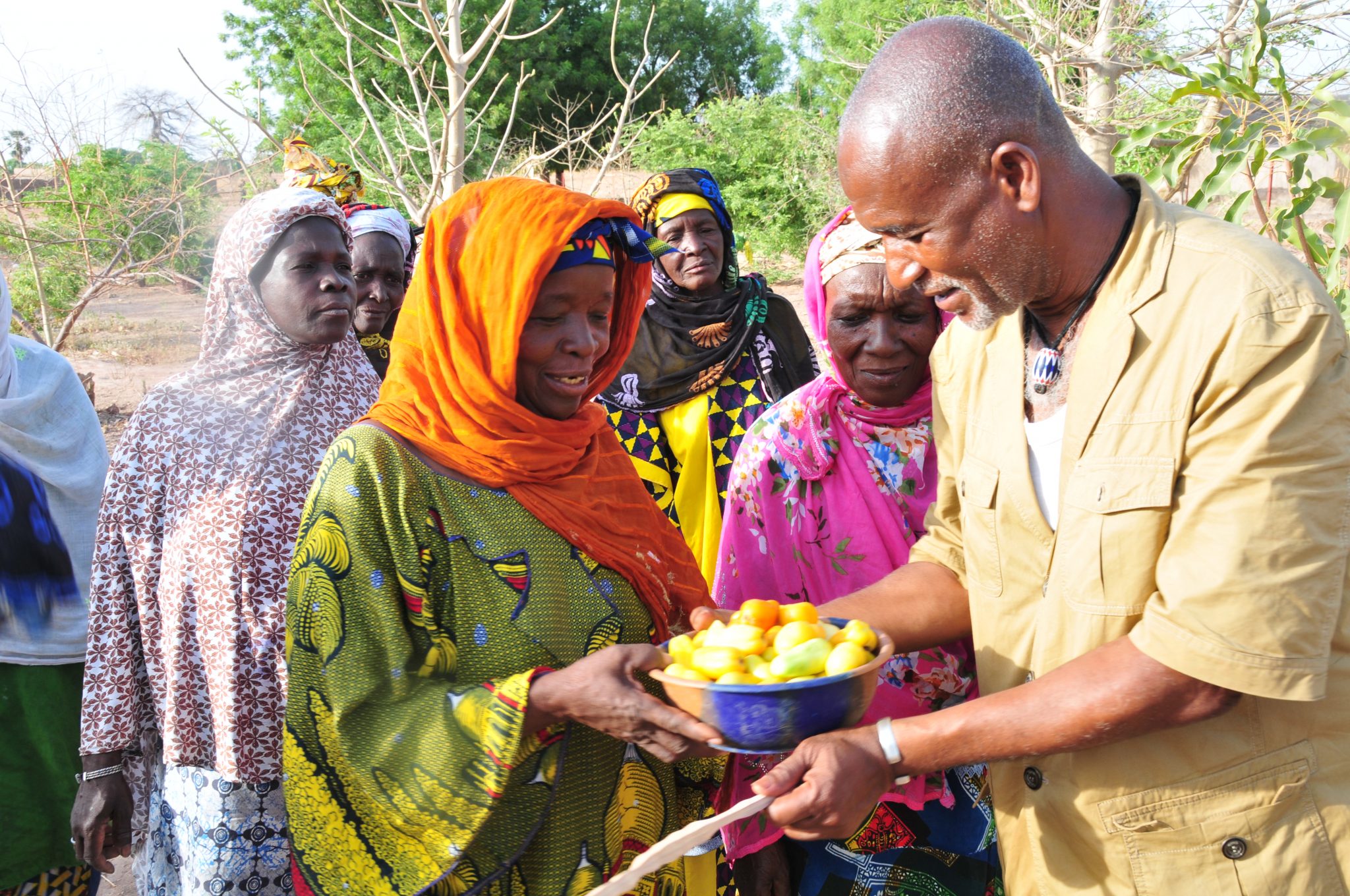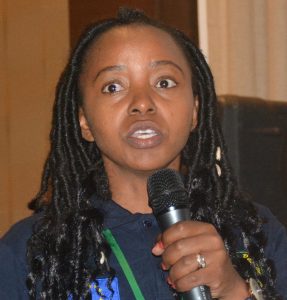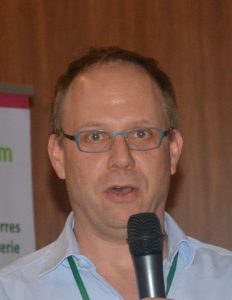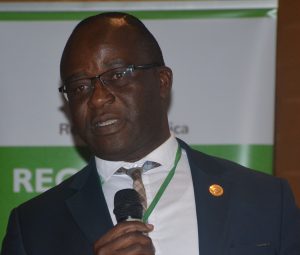
A female farmers shows a sample of her healthy harvest of shea butter in Mali. Photo: Sammy Carsan
Former ways have been reviewed and new approaches put forward at a major conference on land restoration in Mali.
Land-restoration challenges have been presented in the past, great solutions proposed, and targets set at local, regional, national and global levels, however, vast areas of agricultural land remain degraded on the African continent, often well beyond the global average of 20 percent.
Sad but true, food insecurity, low rural incomes and weak resilience persist despite numerous attempts by donors, governments, the private sector and non-governmental organizations. Could we, therefore, be approaching these challenges unwisely?

Susan Chomba speaking during the Regreening Africa session at Beating Famine 2019. Photo: Gilberte Koffi
‘Business as usual has not produced desired outcomes on the African continent,’ pointed out Susan Chomba, Regreening Africa’s programme manager for World Agroforestry, speaking at the Beating Famine conference held held 26–28 February in Bamako, Mali. ‘We need to learn from past mistakes and successes and make decisions informed by evidence.’
The third in a series, the conference shifted focus from building awareness to taking proven successes to massive scale. Regreening Africa spearheaded a session dubbed, ‘How to massively accelerate the scaling-up of land restoration in the Sahel’, in a bid to identify the actors and drivers for increasing the scale of regreening initiatives.
Courtesy of speakers from diverse backgrounds and institutions, it was evident that a paradigm shift to integrate research into development was urgently needed to turn the tide of land degradation. There was no silver bullet to increasing scale because numerous and varied factors contribute to land degradation, including poor farming practices, unfavourable policies that act as disincentives for farmers to invest in long-term restoration, conflicts, migration, and climate-related events such as droughts.
Fortunately, various people, including farmers, government extension agents, local authorities, non-governmental organizations and development agencies are paying attention, questioning why past interventions have not succeeded and looking for ways to do things differently. There was an acknowledgement that there were many ‘white elephants’ littered all over the continent, with little to show in terms of impact once projects had ended. If we continued this way, we would never achieve sustainable impact. So, ‘where do we go from here?’ was the pertinent question.

Jes Weiglet of TMG Research at Beating Famine 2019. Photo: Gilberte Koffi
‘There is a missing middle between service providers and local-level users,’ noted Jes Weiglet of TMG Research. ‘An enabling environment for sustainable land management is key. It requires deliberate policies and investments. We need social innovations to accompany technological innovations in land restoration. An enabling environment, supported by policies and incentives, can stimulate social innovations.’
Through the Stakeholder Approach to Risk Informed and Evidence Based Decision Making (SHARED) developed by World Agroforestry, which brings together stakeholders from different organisations and levels, including farmer representatives, it is possible to build a coalition of partners for increasing scale. The SHARED approach strives to ensure a policy synthesis is conducted so that policy weaknesses and strengths are identified, followed by coordinated, structured, stakeholder engagement to map areas of intervention and, finally, to identify a roadmap for achieving land-restoration targets. The approach attaches significance to co-design of restoration interventions, co-learning through sharing evidence and ensuring that ensuing behaviour changes are tracked.
‘We need rationales for effective partnerships and interventions due to the current limitations in resources, synergies, policies, timeframes and flexibilities,’ said Diawary Boure, country director, Oxfam Mali. ‘There is need to disseminate achievements and multiply interventions.’
‘The moment we start empowering community organisations, there will be accountability at the ground level,’ claimed Patrick Worms, senior science policy advisor with World Agroforestry.
This calls for investments in developing the capacity of extension agents and in the facilitation and recognition of community leaders and ‘champion’ farmers who play key roles in influencing other community members and creating restoration movements from below.
In addition, ‘we need to strengthen key agroforestry commodity value chains through improved harvesting technologies, processing and value addition of agroforestry products and linking farmers to markets,’ said Chomba. ‘This will provide economic benefits that will serve as crucial incentives for land restoration.’

Elvis Tangem, coordinator of the Great Green Wall Initiative. Photo: Gilberte Koffi
There is need for commitment of the private sector in investing more in these initiatives.
‘Looking at the extent of land degradation and the potential for restoration in Sub-Saharan Africa, one individual or organization cannot achieve this on their own,’ emphasized Elvis Tangem, coordinator of the Great Green Wall for the Sahara and the Sahel Initiative of the African Union. ‘Africa’s development agenda doesn’t stop at 15 but 50 years. There is need to leverage the unique strengths of various organizations in order to build synergies and reduce duplication efforts.’
‘The assumption that one size fits all is dangerous,’ asserted Patrice Savadogo, drylands agroforestry systems scientist with World Agroforestry. ‘There is no single technique or practice that can meet all the land restoration needs in all countries. We need to co-design interventions with farmers that suit different ecological, economic and social contexts. This is what we refer to as an options by contexts approach to land restoration. In dryland areas for example, pastoralism is a key livelihood strategy. If we want to fast-track land restoration, we can’t promote initiatives that focus on crop farming only.
‘The current momentum of scaling-up land restoration beyond plot and farm level to the landscape level is a step in the right direction and it needs to be sustained. But we must also acknowledge that we cannot do business as usual, our approaches need to change. Fifty years from now we shouldn’t be talking about land restoration.’
——————————————————————————————————————————————
Regreening Africa is an ambitious five-year project that seeks to reverse land degradation among 500,000 households, and across 1 million hectares in eight countries in sub-Saharan Africa by incorporating trees into croplands, communal lands and pastoral areas, regreening efforts make it possible to reclaim Africa’s degraded landscapes.
This story was produced with the financial support of the European Union. its contents are the sole responsibility of Regreening Africa and do not necessarily reflect the views of the European Union.

